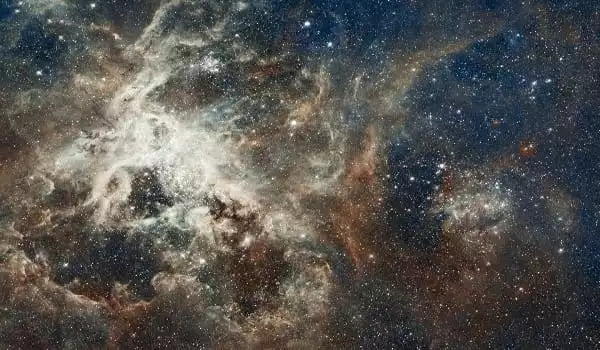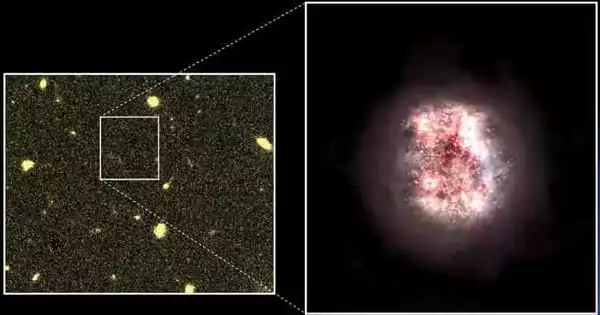Two previously invisible galaxies 29 billion light-years away have been discovered by astronomers at the University of Copenhagen’s Cosmic Dawn Center. Their discovery suggests that up to one in every five of these distant galaxies is hidden from our telescopes due to cosmic dust. The new information alters our understanding of our universe’s evolution since the Big Bang.
The Niels Bohr Institute at the University of Copenhagen has recently discovered two previously invisible galaxies 29 billion light-years away from Earth. The two galaxies have been invisible to the Hubble Space Telescope’s optical lens, hidden behind a thick layer of cosmic dust that surrounds them.
The two invisible galaxies suddenly appeared with the help of the giant ALMA radio telescopes (Atacama Large Millimeter Array) in Chile’s Atacama Desert, which can capture radio waves emitted from the coldest, darkest depths of the universe.
We were looking at a sample of very distant galaxies that we had previously discovered using the Hubble Space Telescope. Then we noticed that two of them had a neighbor who we didn’t expect to see. Due to the dust that surrounds both of these neighboring galaxies, some of their light is blocked, rendering them invisible to Hubble.
Associate Professor Pascal Oesch
“We were looking at a sample of very distant galaxies that we had previously discovered using the Hubble Space Telescope. Then we noticed that two of them had a neighbor who we didn’t expect to see. Due to the dust that surrounds both of these neighboring galaxies, some of their light is blocked, rendering them invisible to Hubble “explains Associate Professor Pascal Oesch of the Niels Bohr Institute’s Cosmic Dawn Center.
The research was recently published in the scientific journal Nature. The two invisible galaxies suddenly appeared with the help of the giant ALMA radio telescopes (Atacama Large Millimeter Array) in Chile’s Atacama Desert.
According to the new findings, the very early universe contains many more galaxies than previously thought. They are simply hidden behind dust made up of small particles from stars. They can now, however, be detected thanks to the ALMA telescope’s high sensitivity and the researchers’ method.
10-20 percent of the universe’s galaxies are missing
Facts about the study:
- The two hidden galaxies are currently known as REBELS-12-2 and REBELS-29-2.
- It took about 13 billion years for light from the two invisible galaxies to reach us.
- Due to the expansion of the universe, the galaxies are now 29 billion light years away.
- The ALMA telescope, which is based on radio signals, was used by the researchers.
- The ALMA Telescope combines the light from all 66 of its antennae to produce a high-resolution image and spectral map of the sky.
By comparing these new galaxies to previously known sources in the very early universe, around 13 billion years ago, the researchers estimate that between 10% and 20% of such early galaxies may still be hidden behind cosmic dust curtains.
“Our discovery shows that up to one in every five of the universe’s earliest galaxies may have been missed from our map of the heavens. We need a proper accounting before we can begin to understand when and how galaxies formed in the universe” Pascal Oesch is quoted as saying.
The new discovery, according to researchers, implies the existence of many more galaxies than previously thought. These galaxies show that there were many massive celestial objects in the early universe. They are simply hidden behind a layer of dust made up of small star particles.

New super telescope will find the missing galaxies
To assist with this task, NASA, ESA, and the Canadian Space Agency have built a new super telescope, the James Webb Space Telescope, which is scheduled to be launched into orbit on December 18, 2021.
The telescope’s increased power and improved technology will allow it to peer even deeper into the universe and contribute new information about its origins. This will help Cosmic Dawn researchers at the Niels Bohr Institute, among other things, see through the cosmic dust.
“The next step is to find the galaxies we missed because there are far more than we thought. That is where the James Webb Telescope will be a game-changer. It will be much more sensitive than Hubble and capable of investigating longer wavelengths, allowing us to easily see these hidden galaxies” Pascal Oesch goes on to say:
“We’re attempting to piece together the big puzzle of the universe’s formation and answer the most fundamental question: ‘Where does it all come from?’ The invisible galaxies discovered in the early universe are some of the first building blocks of the mature galaxies we see around us today. So that’s where it all started.”
After comparing the new galaxies to previously known sources in the early universe, roughly 13 billion years ago, the researchers estimate that between 10% and 20% of such early galaxies may still be hidden behind the veil of cosmic dust. The study also emphasizes the critical role that the James Webb Space Telescope, which is scheduled to launch into orbit on December 18, 2020, will play. Scientists hope that with its advanced technology, they will be able to clear the cosmic fog and get a much clearer picture of our universe.





